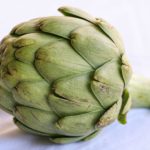When in Rome, Eat Artichokes
 If you're French and you're reading this, do you realise how much of a laugh the Italians are having at your expense?
If you're French and you're reading this, do you realise how much of a laugh the Italians are having at your expense?
My admiration of the cuisine of la belle France knows few bounds except, perhaps, when it comes to today's star ingredient. We refer not the little tubers which cause extreme flatulence, the so called Jerusalem thingies. (Which aren't artichokes at all, and have no connection with Jerusalem.) We are dealing with the globe or Romesco artichoke, a close relative of the thistle.
Many are put off these beauties for the simple reason they have no idea what to do with them. Or, quite possibly, because they've been served them in France. There you are liable to be served the thing whole. Painstakingly you peel it apart, leaf by leaf, extracting the merest smear of flavour from the bottom of each one after dipping it in vinaigrette. The prize awaits after you have stripped off the last leaf and removed the inedible hairy centre, the so called choke. Then and only then do you get to the good bit. I have to confess that I've tried this a few times and become so utterly bored that I've given up.
What do the Italians do? Well generally they cut off all the leaves and throw them away. There is an exception to this as we'll see. Preparing them yourself is a pain. Better by far to go to a market in the spring, and marvel at the speed and dexterity of those who make the peeling simple, much simpler than on this video.

Carciofi alla giudia
On Roman menus you will frequently see carciofi alla giudia. When something is described as Jewish style, it often involves frying, with or without a batter. Jews as a race migrated frquently, usually because of persecution, taking their favoured foods with them. In exactly the same way as our fried fish, this dish travelled originally from north Africa to Spain. When the Jews moved to Rome, it was established in the ghetto, just west of the Teatro Marcello. Its populaity soon spread.
The classical way of making this is to strip off most but not all of the leaves. Deep fry in olive oil for about 15 minutes. Remove and allow to cool. Carefully open up the leaves with a fork. Spinkle with a little white wine and season with s & p. Fry again, stem up, for another five minutes. Drain, season with more salt and pepper and serve at once.
These days you are more likely to be served a less labour intensive version. Strip the artichoke right down to the heart and remove the choke. (After peeling an artichoke put it in water and lemon juice to prevent it discolouring.) Cut into halves or quarters if they are large. Drain, dip in a light batter and deep fry until tender.
Deep frying isn't to everyone's taste. Here's a lovely spring recipe I found in Anna del Conte's Gastronomy of Italy. In an ideal world you'd use new season's peas along with the artichokes, but it'll work just as well with frozen. Remember you'll need to have lemon juice to add to the water in which you'll keep the artichokes after prepping them.
Anna del Conte's Artichokes with Peas
Ingredients (serves 4)
 4 young artichokes, leaves and chokes removed; 2 shallots or 1 small onion, very finely chopped; 50g prosciutto, finely chopped; 3 tbsp olive oil; 15g butter; 150ml warm chicken stock; 300g frozen peas, thawed; s & p.
4 young artichokes, leaves and chokes removed; 2 shallots or 1 small onion, very finely chopped; 50g prosciutto, finely chopped; 3 tbsp olive oil; 15g butter; 150ml warm chicken stock; 300g frozen peas, thawed; s & p.
************************************************
Gently fry the shallots or onion in the butter and oil untils soft. Drain and dry the artichokes. Cut them into halves or quarters according to size. Add then to the pan and cook for about five minutes, turning once or twice. Add the stock. If using fresh peas, add them at this stage. If using frozen, add them a couple of minutes later. Season with s & p. Sauté until the artichokes are tender. This will take about five minutes.